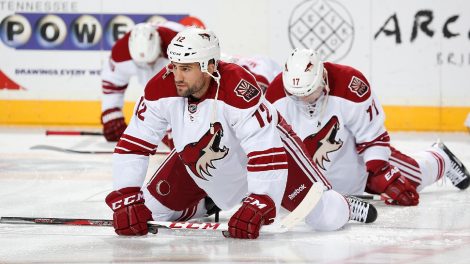EDMONTON — Four slashing penalties in Buffalo Monday night, along with one faceoff violation.
Five slashing penalties in Ottawa, with three faceoff violations.
Nine slashing penalties in New York, one faceoff violation.
Six slashing penalties in New Jersey, three faceoff violations.
In Edmonton and Calgary, where they played split-squad games, the four teams combined for 13 slashing penalties, one faceoff violation and 32 power plays in total. I was in Edmonton and can attest to this: of seven slashing calls, perhaps two of them would have been a penalty last spring.
The rest were born of the National Hockey League’s shiny new standard on slashing. Of course, we’re skeptical. We’ve seen how the NHL operates. But let’s stay positive here, at least until the regular season starts.
We should all be cheering for this new standard to stick. For the NHL to realize it is not lacrosse, where players wield their stick like a weapon.
Who doesn’t want to see the game’s skilled players able to operate, without having to absorb constant slashes to the hands and legs by players who can’t keep up? And if it’s Sidney Crosby who is slashing Mark Methot’s finger to a bloody pulp, well, he should face supplementary discipline as well.
In the end, putting an end to the habit of slashing the puck carrier’s hands will aid the skilled player, and weed out those who can’t keep up. How can that not be good for the game?
“The way our top end guys can skate?” began Edmonton’s Mark Letestu, who welcomes the change on behalf of his club. “I mean, sticks are always parallel on Connor (McDavid). You can’t get in front of the guy. Hopefully we’re on the power play a lot because of it.”
Across the league, linesmen dropped into dressing rooms before the first pre-season games to explain the new faceoff protocols.
“Feet are really important,” Letestu explained. “They don’t want skates touching the hashmarks at all. They want the defensive team paused, then the other team paused, then the drop. They’re calling the rules the way they’re meant to be called.”
Quite a concept, that.
Linesmen have never liked to exercise their obligation of issuing a faceoff violation penalty on the second faceoff infraction. It’s one of those penalties that made coaches crazy, because there was always a way to avoid making that call.
It seems they’ve been instructed to make that call; for now, anyhow.
“I have a tough time believing that in the playoffs, in Game 7, that kind of call is going to be made,” Letestu said. “Right now, there’s an overemphasis on it, and hopefully it doesn’t go all the way back to where it was.”
According to Elias Sports Bureau, power plays went from 8.5 per game in 2003-04 to 11.7 per game in 2005-06, when the NHL came out of its lost season and decided it had to open up the game.
The NHL was down to 6.0 power plays per game last season. The two Alberta contests Monday averaged 16 power plays per game.
With bigger, better goalies — and the never-ending boondoggle that is bloated goalie equipment — goals are back down to pre-lockout levels. Stopping the act of going down on one knee to win a faceoff strips away a key component of the fourth-line, checking centre’s repertoire, and when the first-liners win puck possession, well, we’re already on our way to a more entertaining shift, right?
“Unless guys can figure it out perfectly, I don’t think guys will be able to (drop to a knee) anymore,” said Oilers centre Ryan Nugent-Hopkins.
He’s a career 42 per cent faceoff man, so we’ll assume he was never very good at cheating. If faceoffs become more about skill, and less about body position and strength, that bodes well for Nugent-Hopkins and a lot of the smaller, skilled centremen around the NHL.
And like Letestu, he sees some power play opportunities in his club’s near future. McDavid drew two slashing calls on Monday.
“We’re a pretty quick team. We’ve got some guys who can wheel,” Nugent-Hopkins said. “Like, going wide, most of the time guys don’t have an option other than to give a guy a whack on the hands or the stick, hoping he loses the puck. It’ll help us.”
[snippet ID=3322139]
In the end, we have our doubts as to how long referees will maintain the new standard on slashing. But you have to admit, a parallel stick in the abdomen is still being called as a hook today, a vestige of that lockout from more than a decade ago.
Ryan Kesler followed McDavid around in Round 2 last spring, hacking and whacking him even when the puck was 40 feet away. How that ever became legal is a crime, and hockey is a better place if Kesler has to skate with McDavid to check him.
Why should defenders habitually slash Johnny Gaudreau’s hands just because they’re not skilled or fast enough to take the puck away legally? If you can’t skate with Mitch Marner, why is a healthy slash on the way past considered OK?
It’s long overdue, we’ll all agree on that. The only question is, what will remain of this standard come March 1?
We have our doubts.
[relatedlinks]








